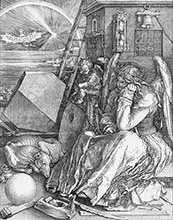About this finishing
Print. The image is printed on the top quality 10-ink HP Z9PS printer on HP matte 270 g / m2 paper. You can choose any size to an accuracy of 1 cm. A margin of 5 cm around the image is added to the size of the motif.


You can find a detailed description about our finishings
here.
Melancholia
Date:
1514Medium:
engravingLocation:
private collection"Melancholia I" is a famous copperplate engraving by the German
Renaissance artist
Albrecht Dürer , completed around 1514. This copperplate is one of the most complex and agonized works Dürer created and has had many interpretations over the years.
In the upper part of the painting, an angel stands with a regular geometric figure in his hand, while a demon sits next to him with his head in his hands. These two figures symbolize the contrast between the spiritual world (the angel) and the melancholy or state of mind (the demon).
The Voyage of The angel holds a geometric object that is sometimes interpreted as the "Melancholic Tetrahedron" or the Dürer Solid, which was a geometric figure that the artist studied. This shape can represent the intellectual or mathematical aspect of melancholy. In the background you can see a clock showing an uncertain time. This can refer to a sense of hopelessness that can be associated with melancholy. At the edge of the image are various tools and implements such as a compass, caliper, scales and a book. These objects are reminiscent of intellectual interests and art, but can also indicate disappointment or unfinished work. A large black dog is depicted in the lower right corner of the painting, which is often interpreted as a symbol of sadness or melancholy. In the background of the painting you can see a flying angel carrying a key in his hand. This angel can represent liberation or the desire for spiritual knowledge.
Dürer painted picture Melancholia in 1514. Prevailing color of this fine art print is green and its shape is portrait. This art piece is located in a private collection This image is printed on demand - you can choose material, size and finishing.
Albrecht Dürer (1471-1528). German painter whose work was produced in a period of great social movements associated with the Reformation. He represents a turning point of the German Gothic style. His creativity, vigour and sensitivity led to the creation of rich and perfect art. Contact with Italian artists allowed him to transfer inspiration from the
Renaissance style (humanism, Greco-Roman classicism, Mediterranean bright colors, etc.) to the height of the German Gothic.


